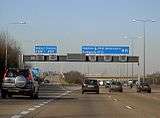National Roads Telecommunications Services
The National Roads Telecommunications Services is the fibre-optic network of communication and control that Highways England uses to monitor England's roads. Its highly complex design has allowed active traffic management, that has led to managed motorways.
History
Previous to 2005, the motorway network was controlled by the National Motorway Communication System (NMCS). This was not inherently fibre-optic or digitally controlled.
The £490 million contract for the NRTS was awarded to the GeneSYS Consortium on 19 September 2005. This was a group of companies led by Fluor (Fluor Corporation) and is a Public–private partnership.
The system is complex enough to allow a national scheme of road pricing, possibly using radio-frequency identification tags. The cost of the project was described by the Association of British Drivers as being an awful lot to spend just for signs saying that motorways are closed and that you should not drink and drive.
Structure
The NRTS is an intelligent transportation system based at the Quinton Business Park at Quinton, Birmingham. Video images are sent over fibre-optic cables to form a switched video network. The fibre-optic system was deployed with Guardian-Lite 3700[1] controllers, which allow IP Ethernet and (full bandwidth) uncompressed video signals to be sent at the same time, made (and invented) by AMG Systems of Biggleswade. The system uses a dual fibre cable. The system is resilient because, using the IP protocol, it can re-route signals if cables are damaged.
Companies
- Fluor
- Peek Traffic
- Mott MacDonald
- Alcatel-Lucent - based the system on its 1692 Metrospan Edge CWDM (coarse wavelength-division multiplexing) platform,[2] with the 7750 Service Router,[3] and OmniPCX enterprise[4] voice-over-IP switch (made by the CSBU subsidiary). Alcatel-Lucent own Genesys Conferencing.
Function
It controls traffic on England's motorways and major A roads.
Customers of the NRTS
- Her Majesty's traffic police (Road Policing Units) and their Police Control Offices
- Traffic England - real-time website
- Traffic Radio
- TrafficMaster
See also
